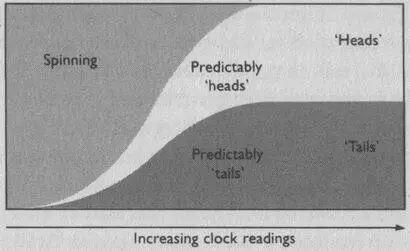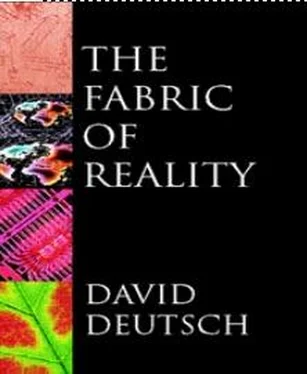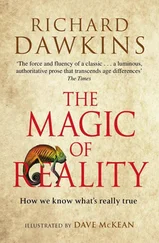David Deutch - The Fabric of Reality
Здесь есть возможность читать онлайн «David Deutch - The Fabric of Reality» весь текст электронной книги совершенно бесплатно (целиком полную версию без сокращений). В некоторых случаях можно слушать аудио, скачать через торрент в формате fb2 и присутствует краткое содержание. ISBN: , Жанр: Физика, Философия, на английском языке. Описание произведения, (предисловие) а так же отзывы посетителей доступны на портале библиотеки ЛибКат.
- Название:The Fabric of Reality
- Автор:
- Жанр:
- Год:неизвестен
- ISBN:0-7139-9061-9
- Рейтинг книги:4 / 5. Голосов: 2
-
Избранное:Добавить в избранное
- Отзывы:
-
Ваша оценка:
- 80
- 1
- 2
- 3
- 4
- 5
The Fabric of Reality: краткое содержание, описание и аннотация
Предлагаем к чтению аннотацию, описание, краткое содержание или предисловие (зависит от того, что написал сам автор книги «The Fabric of Reality»). Если вы не нашли необходимую информацию о книге — напишите в комментариях, мы постараемся отыскать её.
The Fabric of Reality — читать онлайн бесплатно полную книгу (весь текст) целиком
Ниже представлен текст книги, разбитый по страницам. Система сохранения места последней прочитанной страницы, позволяет с удобством читать онлайн бесплатно книгу «The Fabric of Reality», без необходимости каждый раз заново искать на чём Вы остановились. Поставьте закладку, и сможете в любой момент перейти на страницу, на которой закончили чтение.
Интервал:
Закладка:
To elucidate the quantum concept of time, let us imagine that we have sliced the multiverse into a heap of individual snapshots, just as we did with spacetime. What can we glue them back together with? As before, the laws of physics and the intrinsic, physical properties of the snapshots are the only acceptable glue. If time in the multiverse were a sequence of moments, it would have to be possible to identify all the snapshots of space at a given moment, so as to make them into a super-snapshot. Not surprisingly, it turns out that there is no way of doing that. In the multiverse, snapshots do not have ‘time stamps’. There is no such thing as which snapshot from another universe happens ‘at the same moment’ as a particular snapshot in our universe, for that would again imply that there is an overarching framework of time, outside the multiverse, relative to which events within the multiverse happen. There is no such framework.
Therefore there is no fundamental demarcation between snapshots of other times and snapshots of other universes. This is the distinctive core of the quantum concept of time:
Other times are just special cases of other universes.
This understanding first emerged from early research on quantum gravity in the 1960s, in particular from the work of Bryce DeWitt, but to the best of my knowledge it was not stated in a general way until 1983, by Don Page and William Wooters. The snapshots which we call ‘other times in our universe’ are distinguished from ‘other universes’ only from our perspective, and only in that they are especially closely related to ours by the laws of physics. They are therefore the ones of whose existence our own snapshot holds the most evidence. For that reason, we discovered them thousands of years before we discovered the rest of the multiverse, which impinges on us very weakly by comparison, through interference effects. We evolved special language constructs (past and future forms of verbs) for talking about them. We also evolved other constructs (such as ‘ if… then… ’ statements, and conditional and subjunctive forms of verbs) for talking about other types of snapshot, without even knowing that they exist. We have traditionally placed these two types of snapshot — other times, and other universes — in entirely different conceptual categories. Now we see that this distinction is unnecessary.
Let us now proceed with our notional reconstruction of the multiverse. There are far more snapshots in our heap now, but let us again start with an individual snapshot of one universe at one moment. If we now search the heap for other snapshots that are very similar to the original one, we find that this heap is very different from the disassembled spacetime. For one thing, we find many snapshots that are absolutely identical to the original. In fact, any snapshot that is present at all is present in an infinity of copies. So it makes no sense to ask how many snapshots, numerically, have such-and-such a property, but only what proportion of the infinite total have that property. For the sake of brevity, when I speak of a certain ‘number’ of universes I shall always mean a certain proportion of the total number in the multiverse.
If, aside from variants of me in other universes, there are also multiple identical copies of me, which one am I? I am, of course, all of them. Each of them has just asked that question, ‘which one am I?’, and any true way of answering that question must give each of them the same answer. To assume that it is physically meaningful to ask which of the identical copies is me, is to assume that there is some frame of reference outside the multiverse, relative to which the answer could be given — ‘I am the third one from the left…’. But what ‘left’ could that be, and what does ‘the third one’ mean? Such terminology makes sense only if we imagine the snapshots of me arrayed at different positions in some external space. But the multiverse does not exist in an external space any more than it exists in an external time: it contains all the space and time there is. It just exists, and physically it is all that exists.
Quantum theory does not in general determine what will happen in a particular snapshot, as spacetime physics does. Instead, it determines what proportion of all snapshots in the multiverse will have a given property. For this reason, we inhabitants of the multi-verse can sometimes make only probabilistic predictions of our own experience, even though what will happen in the multiverse is completely determined. Suppose, for example, that we toss a coin. A typical prediction of quantum theory might be that if, in a certain number of snapshots, a coin has been set spinning in a certain manner and clocks show a certain reading, then there will also exist half that number of universes in which the clocks show a higher reading and the coin has fallen with ‘heads’ upwards, and another half in which the clocks show the higher reading and the coin has fallen with ‘tails’ upwards.
Figure 11.7 shows the small region of the multiverse in which these events happen. Even in that small region there are a lot of snapshots to illustrate, so we can spare only one point of the diagram for each snapshot. The snapshots we are looking at all contain clocks of some standard type, and the diagram is arranged so that all the snapshots with a particular clock reading appear in a vertical column, and the clock readings increase from left to right. As we scan along any vertical line in the diagram, not all the snapshots we pass through are different. We pass through groups of identical ones, as indicated by the shading. The snapshots in which clocks show the earliest reading are at the left edge of the diagram. We see that in all those snapshots, which are identical, the coin is spinning. At the right edge of the diagram, we see that in half the snapshots in which clocks show the latest reading the coin has fallen with ‘heads’ upwards, and in the other half it has fallen with ‘tails’ upwards. In universes with intermediate clock readings, three types of universe are present, in proportions that vary with the clock reading.
If you were present in the illustrated region of the multiverse, all copies of you would have seen the coin spinning at first. Later, half the copies of you would see ‘heads’ come up, and the other half would see ‘tails’. At some intermediate stage you would have seen the coin in a state in which it is still in motion, but from which it is predictable which face it will show when it eventually settles down. This differentiation of identical copies of an observer into slightly different versions is responsible for the subjectively probabilistic character of quantum predictions. For if you asked, initially, what result you were destined to see for the coin toss, the answer would be that that is strictly unpredictable, for half the copies of you that are asking that question would see ‘heads’ and the other half would see ‘tails’. There is no such thing as ‘which half would see ‘heads’, any more than there is an answer to the question ‘which one am I?’. For practical purposes you could regard this as a probabilistic prediction that the coin has a 50 per cent chance of coming up ‘heads’, and a 50 per cent chance of coming up ‘tails’.

FIGURE 11.7 A region of the multiverse containing a spinning coin. Each point in the diagram represents one snapshot.
The determinism of quantum theory, just like that of classical physics, works both forwards and backwards in time. From the state of the combined collection of ‘heads’ and ‘tails’ snapshots at the later time in Figure 11.7, the ‘spinning’ state at an earlier time is completely determined, and vice versa. Nevertheless, from the point of view of any observer, information is lost in the coin-tossing process. For whereas the initial, ‘spinning’ state of the coin may be experienced by an observer, the final combined ‘heads’ and ‘tails’ state does not correspond to any possible experience of the observer. Therefore an observer at the earlier time may observe the coin and predict its future state, and the consequent subjective probabilities. But none of the later copies of the observer can possibly observe the information necessary to retrodict the ‘spinning’ state, for that information is by then distributed across two different types of universe, and that makes retrodiction from the final state of the coin impossible. For example, if all we know is that the coin is showing ‘heads’, the state a few seconds earlier might have been the state I called ‘spinning’, or the coin might have been spinning in the opposite direction, or it might have been showing ‘heads’ all the time. There is no possibility of retrodiction here, even probabilistic retrodiction. The earlier state of the coin is simply not determined by the later state of the ‘heads’ snapshots, but only by the joint state of the ‘heads’ and the ‘tails’ snapshots. Any horizontal line across Figure 11.7 passes through a sequence of snapshots with increasing clock readings. We might be tempted to think of such a line — such as the one shown in Figure 11.8 — as a spacetime, and of the whole diagram as a stack of spacetimes, one for each such line. We can read off from Figure 11.8 what happens in the ‘spacetime’ defined by the horizontal line. For a period, it contains a spinning coin. Then, for a further period, it contains the coin moving in a way that will predictably result in ‘heads’. But later, in contradiction to that, it contains the coin moving in a way that will predictably result in ‘tails’, and eventually it does show ‘tails’. But this is merely a deficiency of the diagram, as I pointed out in Chapter 9(see Figure 9.4, p. 212). In this case the laws of quantum mechanics predict that no observer who remembers seeing the coin in the ‘predictably heads’ state can see it in the ‘tails’ state: that is the justification for calling that state ‘predictably heads’ in the first place. Therefore no observer in the multiverse would recognize events as they occur in the ‘spacetime’ defined by the line. All this goes to confirm that we cannot glue the snapshots together in an arbitrary fashion, but only in a way that reflects the relationships between them that are determined by the laws of physics. The snapshots along the line in Figure 11.8 are not sufficiently interrelated to justify their being grouped together in a single universe. Admittedly they appear in order of increasing clock readings which, in spacetime, would be ‘time stamps’ which would be sufficient for the spacetime to be reassembled. But in the multiverse there are far too many snapshots for clock readings alone to locate a snapshot relative to the others. To do that, we need to consider the intricate detail of which snapshots determine which others.
Читать дальшеИнтервал:
Закладка:
Похожие книги на «The Fabric of Reality»
Представляем Вашему вниманию похожие книги на «The Fabric of Reality» списком для выбора. Мы отобрали схожую по названию и смыслу литературу в надежде предоставить читателям больше вариантов отыскать новые, интересные, ещё непрочитанные произведения.
Обсуждение, отзывы о книге «The Fabric of Reality» и просто собственные мнения читателей. Оставьте ваши комментарии, напишите, что Вы думаете о произведении, его смысле или главных героях. Укажите что конкретно понравилось, а что нет, и почему Вы так считаете.












